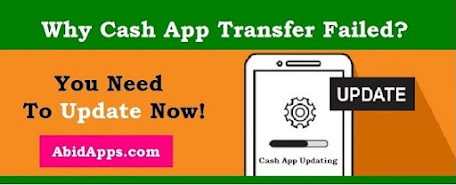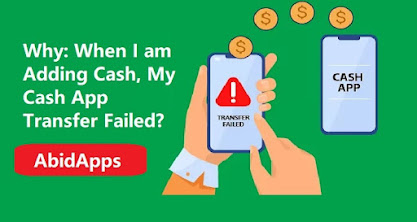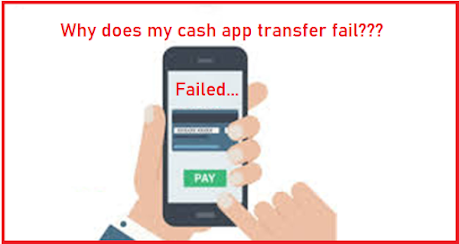Cash App Transfer Failed: Complete Guide To Fix The Issue
There are going to be numerous botched transactions with billions of cash and money transfers every day. It’s all about the statistics, and the square cash app is no exception. Transfers on Cash App in particular have a history of failing for unknown reasons. To avoid this from happening again, what can you do? The following are some of the possible causes of Cash App transfer failed.
Transfer Failed Cash App Has Been Declined By Your Bank Or Credit Card Company
It’s safe to say that this is the most typical cause of transfer failed Cash App. It’s also the most nebulous. 9 times out of 10 you’ll be forced to contact your bank or credit card company to resolve the problem. The bank may reject the transaction for a variety of reasons, including insufficient money, a frozen account status, an incorrect card number, or incorrect expiration date.
You can either try to complete the transaction again after making sure all the details are right or, if that fails, you can call the bank. As a reminder, Cash App will always direct you to your bank or card issuer or tell you to try a different one if this happens. To open an account with a bank or card issuer, you may be required to provide a limited amount of information, which may or may not include the ability to send or receive money. Another cause for a failed transfer is that some prepaid cards don’t work properly with Cash App. That’s just the beginning.
No Money In The Bank Account: This is a no-brainer. If you try to send money to Cash App but don’t have enough in your bank account, your transfer will be rejected. Make sure you have enough money in your account before making a transfer. Cash App withdrawals to a bank account or another person are just as simple. It shows your Cash App payment failed, i.e. not even begin, if you don’t have enough money in your Cash App balance.
Fraudulent Activity: You’re more likely to make this mistake than you think. In many cases, the message reads “Cash app payment canceled for your protection.” See, every financial institution, including Cash App, is required to follow anti-money laundering and anti-terrorism legislation.
Sometimes, the algorithm gets a little overzealous and identifies normal transactions as fraudulent and cancels them right away to comply with the rules. Some people are more susceptible to this than others, but there are techniques to lessen and prevent the problem from occurring.
Problems With The Cash App Or The Bank’s Technology
All of us are aware that nearly nothing on the internet is completely error-free. The same holds for apps that help you manage your money. These items are prone to frequent crashes, and on rare occasions, they just fail to function. You may want to check to see if there are any problems with the institutions involved in the transfer.
Limitations On The Use Of The Cash App
Some restrictions will be placed on accounts that have not been validated by Cash App. Cash transfers in the United States are limited to $250 each week or $1,000 in 30 days. And in the UK, the weekly cap for sending and receiving money is £250 and £500, respectively. If you want to utilize the Cash App to get your paycheck, you may find that the limits are too low. However, if the $1,000 monthly limit is not enough for you, you can easily increase these restrictions.
Instructions How To Increase Cash App Limit?
To increase your Cash App limit, you must provide your birth date, first and last name and the last four digits of your Social Security Number to validate your account (SSN). You must also validate your account to receive a Cash Card, the app’s debit card. So, if you plan to use Cash App for an extended period, or even just occasionally, you should do this.
If Cash App is unable to verify your identity using your name, DOB, and SSN, it may ask for further information such as papers. This is all a part of the KYC, or “Know Your Customer” process, which is common in the sector.
Errors In Personal Data And/Or Cards
One of the most common causes of a failed transfer is a lack of communication between the parties involved. It’s sometimes difficult to distinguish between the various cards available on the market. It’s also critical that you provide accurate information.
What Credit Cards Are Accepted By Cash App?
All major credit and debit cards are accepted by Cash App and other similar financial, banking, and money management apps. MasterCard, Visa, American Express, and Discover are just a few examples. Most prepaid cards are supported, but deposits to these cards do not operate. Although widely used and convenient, prepaid cards do not always work well with digital banks.
Over 30 million people used the Square Cash App in June of this year, according to an announcement from the company. Users and retailers alike encountered problems during the coronavirus outbreak, though. When it comes to sending money, a lot of people use the Cash App. Peer-to-peer payment transfer relies heavily on this application, which is why it’s so popular. However, Cash App transfer failed have been reported by users. Errors became a major issue as users tried to fix them.
If a Cash App transfer fails, you may encounter errors. If this is the case, we highly recommend that you read the entire blog because the majority of the mistakes were fixed by customers who followed the basic principles. We’ve done our best to lay out some of the most common blunders people make when using Cash App, as well as how they can be fixed. There are several reasons why a user may have difficulty transferring money, and we’ve highlighted the most common ones that can be easily fixed:
You Should Constantly Check Your Internet Connection.
You can’t use Cash App if you have a slow internet connection because it demands a strong connection. Because of this, you must always ensure that your web connection is active before making a transaction on the Cash App.
Version Of The Cash App: Your cash app transactions may be failing because you haven’t made a big change to your application. The latest Cash App upgrades are required, so be sure to check your device’s app store for the latest version.
Restrictions For Cash App: If you’re using the Cash App, you can send and receive up to $1000 in 30 days, according to the app. To raise these restrictions, a consumer must provide his full name, date of birth, and the last four digits of his Social Security Number. Cash App allows users to send and receive an unlimited amount of money after they’ve been verified.
Verify The Recipient’s ID: Before starting a transaction, make sure you have the correct recipient ID. You can identify and connect two people who have never met before by comparing their recipient IDs, which are required by the Cash App.
Authentication of an Individual’s Identity: “Cash App this transfer failed” has been a common error for the unverified. At the very least, you’ll need to update your name, birth date, and social security number to use the Cash App.
Error In Cash App Transfer: Take a few simple steps to ensure a smooth transfer of funds from your bank account to your Cash App account. A functional high-speed internet connection is now required by virtually every program. When using Wi-Fi, the device must be within a range of 300 feet of the Wi-Fi router to receive internet signals.
Before making a transaction, make sure to verify your account balance; it will be displayed in the top center of the Cash App home screen on a mobile device. The vast majority of Cash App customers are unaware of the balance in their accounts, hence the cash app transfer fails.
Expired Cards: Many cards remain linked to accounts even after their expiration date has passed. A “Declined, please check the card number, expiration date, CVV, and ZIP Code” problem message appears for this user. When your card expires, you’ll need to update your account details and attach a new card to Cash App.
Recipient’s Information: Re-checking the recipient’s information is essential, as inaccurate information can cause the transfer to fail. Please double-check your input to ensure accuracy. The cashback won’t be available if the money is sent to the wrong address.
When A Bank Denies A Cash App Payment For A Variety Of Reasons, Consider The Following Alternatives: There is a chance that you will not be able to transfer funds if the bank robotic system/human believes it is suspicious. Contact your bank to remove the hold and transfer the funds if you are the one making the transfer. If your bank account does not have enough money in your checking account by which you are transferring, the transaction will always fail.
The Cash app keeps an eye out for any attempts at fraud or other irregularities with your account. Also, there are two ways to withdraw money from the Cash app: Instant and Standard. When using the standard option, the transfer can take up to three days; however, if you choose the instant option, the funds are transferred to your bank account immediately.
The Cash App Won’t Allow Me To Transfer Money: If you’re having trouble sending money through the Cash app, double-check that the recipient’s address is entered correctly. This is because it has been shown that many people use the Cash app incorrectly, causing their transactions to fail. Another important factor is that the payment is being rejected by the user’s bank.
“Cash app payment failed” or “This transfer failed on Cash app” notifications can be caused by either insufficient funds or inaccurate recipient details. If this is the case, you should check to see if the recipient is correct and if you have sufficient funds to conduct the transaction. As a reminder, if your Cash app card is refused, it is likely because you supplied inaccurate information, such as the wrong card numbers or expiration dates. When you try to pay using a debit or credit card that has been disabled or expired, you will receive this message.
Why Can’t I Use Cash App To Make A Quick Deposit?
Because some debit cards don’t support quick transactions regularly, the Cash app needs time to credit your wallet with funds. Using a different card on the Cash app may help if you’re experiencing this problem regularly. The cash app accepts a wide range of cards including Visa, Mastercard, American Express, and Discover.
By now, you should be aware of the three methods available for funding your Cash App account. Using a debit card, you can first deposit money into the Cash App. You can also ask a friend or family member who has a Cash App for money. Thirdly, you may add money to your Cash App by shopping at places like Walmart, Walgreens, and Dollar General, as well as by using your debit or credit card.
Let’s imagine you can’t add money to your Cash App card with a debit card. Other possibilities include a defunct or incorrectly entered credit or debit card number or CVV code, or incorrect expiration date. It is also possible that you do not have enough money in your debit card.
Transferring money from your credit card to your Cash App has failed. Is this really what you’re attempting to do with your credit card? Keep your hands on the wheel! It’s time to stop. Why? This is because a credit card could not be used to fund the Cash App. You can use a credit card to pay for other things on the Cash App, but not this transaction.
The recipient of your request has refused your request if you requested money from your Cash App contact and received nothing in return. On the other hand, if you are unable to add money to the Cash App at a department store, check to see whether the cash card is expired, damaged, or frozen.
Also, read about cash app direct deposit pending or why your cash app direct deposit pending or cash app direct deposit or direct deposit pending in cash app



Comments
Post a Comment